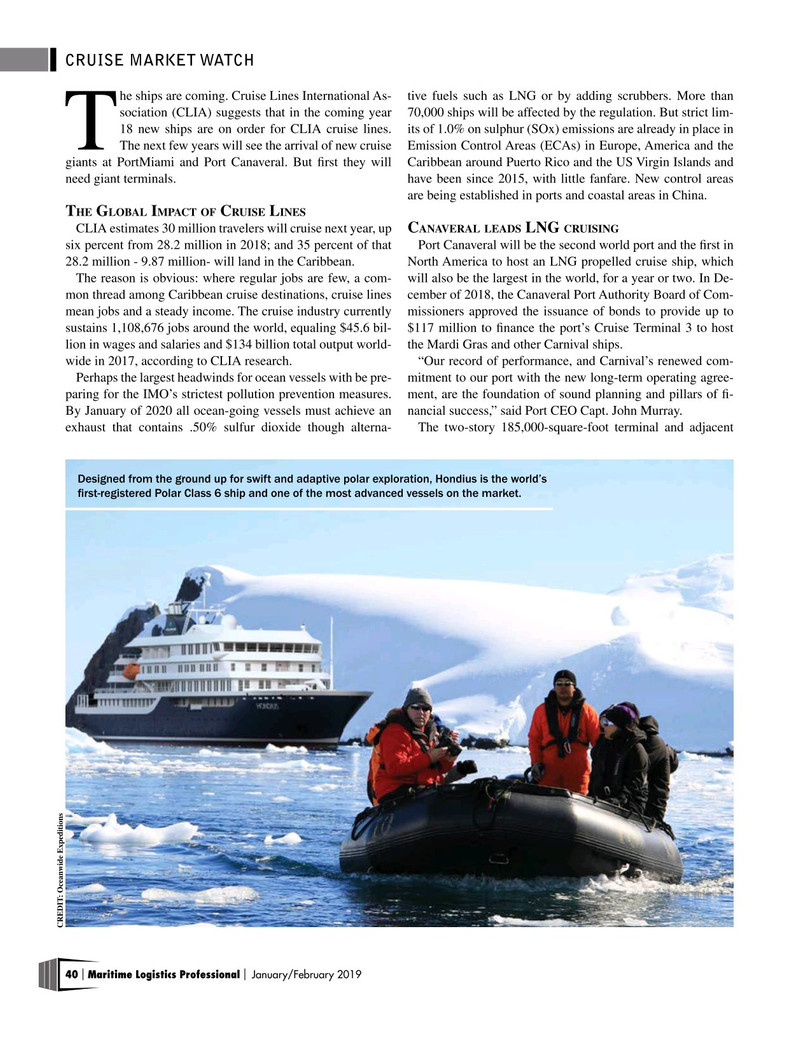
Page 40: of Maritime Logistics Professional Magazine (Jan/Feb 2019)
Cruise Ports Annual
Read this page in Pdf, Flash or Html5 edition of Jan/Feb 2019 Maritime Logistics Professional Magazine
CRUISE MARKET WATCH he ships are coming. Cruise Lines International As- tive fuels such as LNG or by adding scrubbers. More than sociation (CLIA) suggests that in the coming year 70,000 ships will be affected by the regulation. But strict lim- 18 new ships are on order for CLIA cruise lines. its of 1.0% on sulphur (SOx) emissions are already in place in
T The next few years will see the arrival of new cruise Emission Control Areas (ECAs) in Europe, America and the giants at PortMiami and Port Canaveral. But frst they will Caribbean around Puerto Rico and the US Virgin Islands and need giant terminals. have been since 2015, with little fanfare. New control areas are being established in ports and coastal areas in China.
T g i C l he loBal mpaCT of ruise ines
CLIA estimates 30 million travelers will cruise next year, up C lng anaveral leads Cruising six percent from 28.2 million in 2018; and 35 percent of that Port Canaveral will be the second world port and the frst in 28.2 million - 9.87 million- will land in the Caribbean. North America to host an LNG propelled cruise ship, which
The reason is obvious: where regular jobs are few, a com- will also be the largest in the world, for a year or two. In De- mon thread among Caribbean cruise destinations, cruise lines cember of 2018, the Canaveral Port Authority Board of Com- mean jobs and a steady income. The cruise industry currently missioners approved the issuance of bonds to provide up to sustains 1,108,676 jobs around the world, equaling $45.6 bil- $117 million to fnance the port’s Cruise Terminal 3 to host lion in wages and salaries and $134 billion total output world- the Mardi Gras and other Carnival ships.
wide in 2017, according to CLIA research. “Our record of performance, and Carnival’s renewed com-
Perhaps the largest headwinds for ocean vessels with be pre- mitment to our port with the new long-term operating agree- paring for the IMO’s strictest pollution prevention measures. ment, are the foundation of sound planning and pillars of f-
By January of 2020 all ocean-going vessels must achieve an nancial success,” said Port CEO Capt. John Murray.
exhaust that contains .50% sulfur dioxide though alterna- The two-story 185,000-square-foot terminal and adjacent
Designed from the ground up for swift and adaptive polar exploration, Hondius is the world’s frst-registered Polar Class 6 ship and one of the most advanced vessels on the market.
CREDIT: Oceanwide Expeditions 40 Maritime Logistics Professional January/February 2019 | |

 39
39

 41
41
